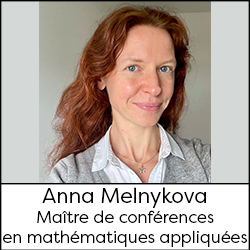[Portrait] Anna Melnykova, teacher-researcher in applied mathematics (UPR LMA)

What is your research about?
I'm interested in mathematical models of neuronal activity. We know that the neurons in the brain communicate with each other by means of small electrical discharges ("spikes").
What information can we glean from observing these discharges? Is their nature completely deterministic or is there also an element of chance? I think so, of course (since I work in probability)! Can we reconstruct the neural network from the spikes?
Can we estimate the physical parameters of neurons? Can they be accurately simulated? I'm trying to understand!

What are your current scientific activities?
I am currently working on simulation of the stochastic Hodgkin-Huxley model. This model gives a very precise description of the dynamics of a neuron's membrane. Precise' also means 'complicated' (at least from the mathematicians' point of view). With my colleague, we found (in less than a week!) a very efficient method for simulating these dynamics... and we've now been trying for two years to prove (mathematically) that it works.
Why did you choose to work in academic research?
In research, you choose your subject and your colleagues, and it's up to you to manage your time and your priorities. Basically, you're paid to solve puzzles with your colleagues - it's a privilege! And, as is often the case with riddles, there's that intellectual pleasure that ranges from "Oh, that's hard, I don't understand a thing" to "Oh, but it's actually easy" (sometimes after several months' work...). In short, research is never easy, but it's a lot of fun!
What advice would you give to students who want to do research?
In my opinion, there are three essential qualities to be a good researcher: curiosity, autonomy and intellectual humility. Everyone has gaps in their knowledge! But if you're aware of your gaps, if you want to fill them and if you're capable of trying to understand things yourself (sometimes to no avail!), without waiting for someone else to do it for you, then you have the potential to do research. For the rest, you need to work hard... and write hard!
What object or image from your business best illustrates you?
Research in applied maths is often a lot of formulas, a lot of time on the computer... and a lot of coffee! I've done my best to illustrate this.

The Avignon Mathematics Laboratory (UPR 2151 LMA)
The Laboratoire de Mathématiques d'Avignon (formerly the Laboratoire d'Analyse non linéaire et Géométrie) was created in 1989 from two research groups in convex analysis and geometry. It brings together all the mathematicians at Avignon University. In 2009, the laboratory opened up to a third research group: statistics.
It currently has nineteen permanent teacher-researchers divided into three teams: the non-linear analysis and optimisation team, the dynamic systems and geometry team, and the statistics team.
Its main aim is to bring together and support researchers active in the research themes of these three teams, to encourage national and international collaborations and to promote the reception of doctoral students.
The portraits
Updated on 5 March 2025